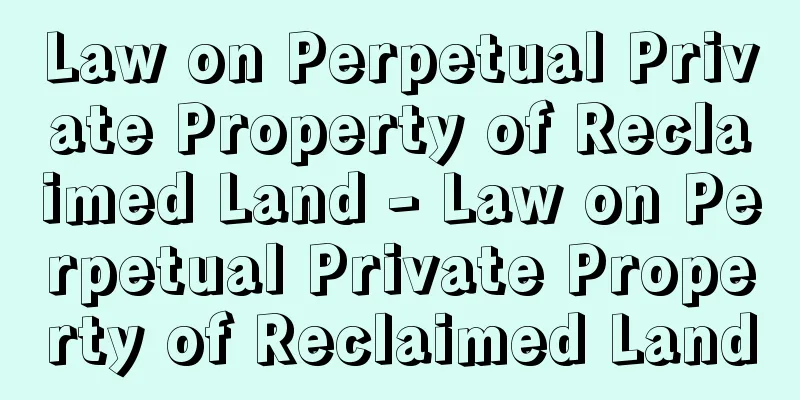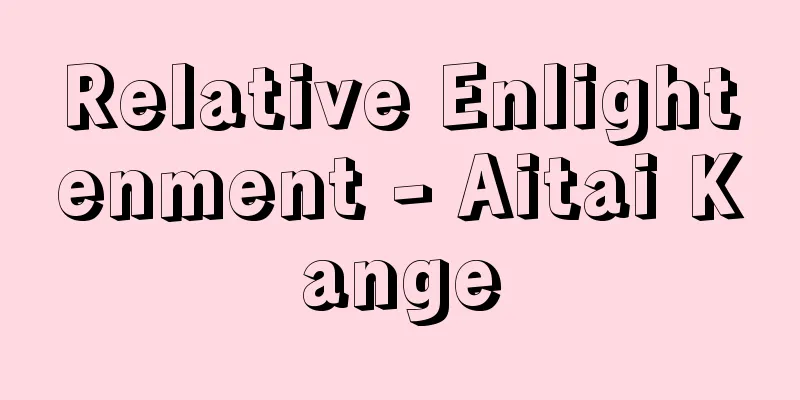Law on Perpetual Private Property of Reclaimed Land - Law on Perpetual Private Property of Reclaimed Land

|
This ancient land law was issued 20 years after the Sansei Isshin Law in 743 (Tenpyo 15). It removed the restrictions on the period of possession such as Sansei and Isshin that existed in the Sansei Isshin Law, and allowed reclaimed land to be privately owned forever, but set restrictions on the area based on rank (from 500 cho for 1st rank (pon) and 1st rank to 10 cho for mui). Unlike the Sansei Isshin Law, this law was fundamentally contrary to the principles of the Ritsuryo Land Law, and is believed to have been enacted with the policy intentions of Tachibana no Moroe, who had just been promoted to the position of Minister of the Left at the time. However, in the end, it also served to fill in the gaps in the Ritsuryo Land Law by setting a limit on the amount of land that could be reclaimed. The Handen Shujuho continued to be applied to already cultivated land, while this law was only applicable to newly cultivated land, and so the two could coexist. However, since the permanent private ownership of rice paddies was openly recognized, the movement of private land ownership by aristocrats, local clans, and temples and shrines suddenly became active, which was a major cause of the establishment of the Shoen system, and also caused the collapse of the Handen Shujuho. Furthermore, with the promulgation of this law, the original concept of public land and private land in the Ritsuryo Law, which was based on the presence or absence of land sovereignty, regressed, and instead, the concept of public land and private land, which was based on the presence or absence of permanent private ownership, was created and became common. In 765 (Tenpyo Jingo 1) under the administration of Dokyo, all land reclamation was prohibited except for continuous land reclamation by temples and small-scale land reclamation by local farmers, but after Dokyo's downfall in 772 (Hōki 3), the old rules were restored and never changed. [Toshiya Torao] [Reference] | |Source: Shogakukan Encyclopedia Nipponica About Encyclopedia Nipponica Information | Legend |
|
三世一身法の後を受けて、20年後の743年(天平15)に発布された古代の土地法。三世一身法に存した三世とか一身とかの占有期間の制限を外し、墾田は永久に私有地とすることを認め、ただその面積に位階による制限(一品(ぽん)および一位の500町から無位の10町まで)を設けた。このように三世一身法と違って律令(りつりょう)土地法の理念と根本的に反する法が出された背景には、当時左大臣に昇任したばかりの橘諸兄(たちばなのもろえ)の政策的意図があったとみられる。ただし結果的には、開墾限度額を設定して律令土地法の欠落部分を補完したという一面をももっていた。班田収授法は依然として既墾地で行われ、この法は新規の開墾地でのみ通用するわけであるから、両者は共存しうるものではあったが、水田の永久私有が公然と認められた以上、貴族、地方豪族、社寺の土地私有の動きはにわかに活発となり、荘園(しょうえん)制成立の大きな原因となるとともに、他方、班田収授法崩壊の原因ともなった。なおこの法の発布によって、これまでの田主権の有無を指標とする律令法本来の公田・私田概念は退行し、かわって永代私有権の有無を指標とする公田・私田概念が生み出され一般化するに至った。道鏡(どうきょう)政権下の765年(天平神護1)に、寺院の継続的な開墾と現地農民の小規模な開墾を除くほかの、いっさいの開墾を禁止したことがあるが、道鏡失脚後の772年(宝亀3)に旧に復し、以後変わることはなかった。 [虎尾俊哉] [参照項目] | |出典 小学館 日本大百科全書(ニッポニカ)日本大百科全書(ニッポニカ)について 情報 | 凡例 |
Recommend
A short story - Ichigon Hodan
This book is a compilation of sermons that revolv...
National Treasury Disbursements - Kokkoshishutsukin
The national government covers all or part of the...
Tales of Tenjiku Tokubei in Korea - Tales of Tenjiku Tokubei in Korea
A Kabuki play. Historical piece. Five acts. Writt...
Porter, H.
…The Australian representatives of the countercul...
Márquez, FG (English spelling) MarquezFG
… [Democratic transition period] In the general e...
International Institute for Social History (English: International Institute for Social History)
This is a socialist archive and museum in Amsterda...
Catalog of Imperial Artworks - Gomotsuon Emo Kuroku
It lists Chinese paintings in the possession of su...
Red pox - red pox
〘Name〙 = Akamogasa (red smallpox) *Nihon Kiryo - J...
Scattered writing - Handbills
A type of calligraphy used in waka poetry and kan...
Taglioni, Maria
Born: April 23, 1804 in Stockholm [Died] April 24,...
Life type
A classification of the life style of an organism....
Merchant bank
A financial institution active in London's lon...
Kronshtadt (English spelling)
A city in the Leningrad Oblast in northwestern Rus...
Echigo Jofu
Among the hemp fabrics produced mainly in Ojiya, ...
Sex change - Sex epilepsy
This refers to the phenomenon in which an individ...


![Meghalaya [State] (English spelling)](/upload/images/67ccfeeb2d2c6.webp)






